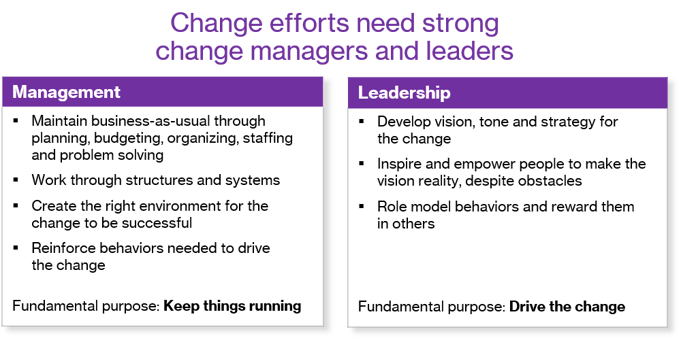More often than not, change initiatives fail. In fact, the brutal truth is that over 70% of change initiatives fail because they focus solely on rational aspects such as systems, processes and skills. Leaders often neglect to address the human elements that accompany major transitions, including the different emotional journeys people experience, multiple vested interests that are often present, and a whole diversity of perspectives on, and reactions to, any particular change.
Leading change management can be a change in anything from a shift in process, location or top leader, to integrating two companies following a merger or acquisition. Regardless of the scale of change, it will impact someone within the business. And it’s up to you and other key leaders to manage that impact to ensure benefits are realized and the change sticks.
People make organizations complex. As a result, we cannot rely on simple cause and effect when leading change. The leader’s role is navigating that complexity, understanding what makes people tick and using that knowledge to inspire and motivate change. It’s the hallmark of a great change leader.
And how is a change leader different than a change manager? A change leader’s fundamental purpose is to set the vision, tone and strategy to drive the change, while a change manager’s purpose is to execute and keep things running throughout the change. 
Both roles are critical to making change stick and are summed up in this video:
To embrace the disruptive effects of change and seize the opportunities it brings, great change leaders need to:
- Step up to the mark and stay abreast of industry and market trends to respond to change proactively.
- Navigate the organization through what are often choppy waters without losing trust.
- Motivate and inspire people to be resilient through the constant ups and downs of transition periods while maintaining both theirs and your focus and personal wellbeing.
Leading change management can be a formidable task, requiring different ways of thinking to succeed. It’s not simply about delivering on a change management plan. In our experience, four basic ground rules can make the difference between a process that fails and one that leads the organization toward a sustainable pathway to change that sticks.
To be a successful change leader and drive the change, you should:
- Inform your team of the rationale and benefits of any change you introduce.
- Use tactics that engage and involve them in the change.
- Enable success by removing obstacles and managing resistance effectively.
- Build trust and influence others through your behavior.
Change is everywhere. Stay tuned for more on this important topic and please share your thoughts below on how you lead change within your organization.
Blog Contributors
 |
Phil Merrell is the Director of Change Consulting, EMEA and Global Change Management Lead at Willis Towers Watson. |
 |
Gaby Joyner is the Director of Willis Towers Watson’s Change Consulting practice in Great Britain. |




